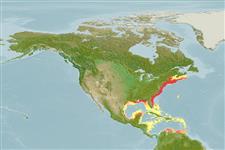Environment: milieu / Klimaatzone / Diepte / distribution range
Ecologie
marien; brak water demersaal; diepte 15 - 170 m. Temperate; 46°N - 10°N, 98°W - 60°W
Western Atlantic: Nova Scotia in Canada to central Florida in USA. Gulf of Mexico (Ref. 26938).
Grootte / Gewicht / Leeftijd
Maturiteit: Lm ? range ? - ? cm
Max length : 38.0 cm TL mannelijk / geslacht onbekend; (Ref. 7251); common length : 30.0 cm TL mannelijk / geslacht onbekend; (Ref. 3822)
Occurs on sandy bottom. Feeds on shrimps, crabs, other crustaceans, squid, bivalves and small fishes. Produces loud, drumming sound by vibrating its swim bladder (Ref. 9988). Used both for food and fish meal; other uses include bait for lobster traps and flatfish, handlines, pet food and fertilizer. Utilized fresh and frozen; also used for caviar ; can be broiled and baked (Ref. 9988).
Levenscyclus en paargedrag
Maturiteit | Voortplanting | Paaien | Eieren | Fecunditeit | Larven
Robins, C.R. and G.C. Ray, 1986. A field guide to Atlantic coast fishes of North America. Houghton Mifflin Company, Boston, U.S.A. 354 p. (Ref. 7251)
Status op de Rode Lijst van het IUCN (Ref. 130435: Version 2025-1)
Gevaar voor de mens
Harmless
Gebruik door de mens
Visserij: van minder commercieel belang; aas: occasionally
Tools
Speciale rapporten
Download XML
Internetbronnen
Estimates based on models
Preferred temperature (Ref.
123201): 6.4 - 24.7, mean 18.9 °C (based on 85 cells).
Fylogenetische diversiteitsindex (Ref.
82804): PD
50 = 0.5000 [Uniqueness, from 0.5 = low to 2.0 = high].
Bayesian length-weight: a=0.00513 (0.00258 - 0.01018), b=3.19 (3.01 - 3.37), in cm total length, based on LWR estimates for this species & (Sub)family-body (Ref.
93245).
Trofisch niveau (Ref.
69278): 4.1 ±0.0 se; based on diet studies.
Generation time: 3.7 ( na - na) years. Estimated as median ln(3)/K based on 1
growth studies.
Weerstandsvermogen (Ref.
120179): Gemiddeld, minimale populatieverdubbelingstijd 1,4-4,4 jaar (K=0.3).
Fishing Vulnerability (Ref.
59153): Low to moderate vulnerability (35 of 100).
🛈
Nutrients (Ref.
124155): Calcium = 49.7 [26.9, 103.6] mg/100g; Iron = 0.418 [0.221, 0.752] mg/100g; Protein = 16.6 [14.1, 19.5] %; Omega3 = 0.686 [0.305, 1.832] g/100g; Selenium = 14.8 [7.1, 33.4] μg/100g; VitaminA = 22.9 [8.7, 63.4] μg/100g; Zinc = 0.571 [0.403, 0.805] mg/100g (wet weight);
